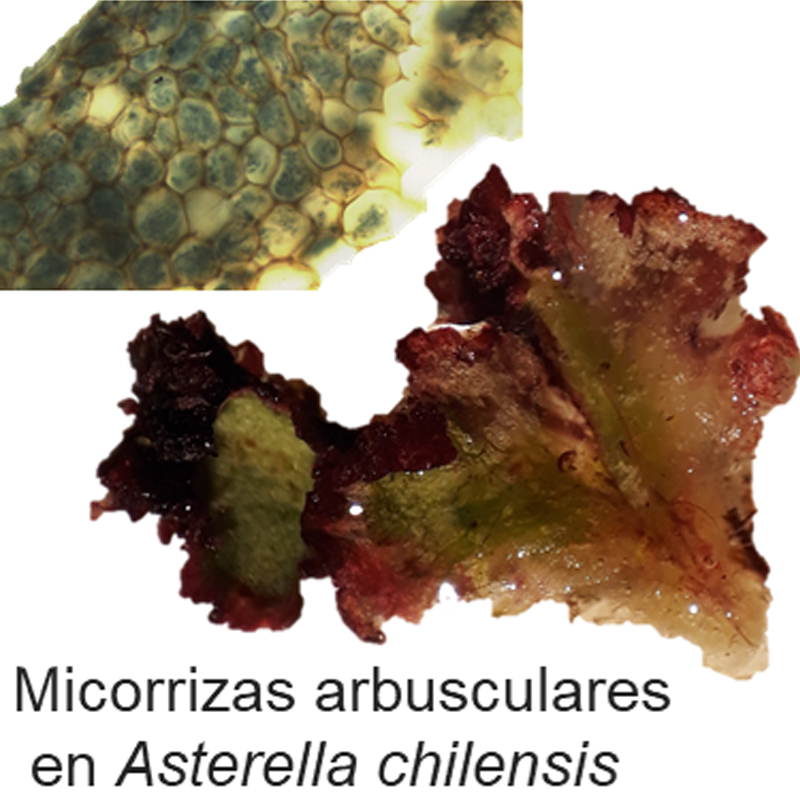Nuevo registro de micorriza arbuscular en Asterella chilensis (Aytoniaceae, Marchantiophyta), Patagonia, Argentina
DOI:
https://doi.org/10.31055/1851.2372.v57.n1.35364Palavras-chave:
Asociación fúngica, hepática, Tipo ParisResumo
Introducción y Objetivos: Las asociaciones que se establecen entre micorrizas arbusculares (MA) y briofitas (Anthocerotophyta, Bryophyta y Marchantiophyta) juegan un papel importante en el desarrollo de este grupo de plantas. En particular, la relación entre MA y Marchantiophyta ha sido estudiada previamente en diferentes especies y regiones del mundo y, entre otras cosas, se menciona que la colonización por hongos puede diferir en abundancia y ocurrencia incluso en especies del mismo género. El objetivo de este estudio es presentar y caracterizar por primera vez la colonización de MA en Asterella chilensis (Aytoniaceae).
M&M: El material examinado proviene de colecciones realizadas en ambientes de estepa de la Patagonia argentina. Las plantas fueron acondicionadas, teñidas y analizadas de acuerdo con técnicas específicas para briofitas.
Resultados: Se describe por primera vez la asociación micorrícica en A. chilensis. Se presenta una breve descripción e ilustración de la planta y se comentan las estructuras características de las MA. El porcentaje de colonización osciló entre el 35 y el 38% y la MA corresponde al tipo Paris, caracterizado por la presencia de hifas aseptadas que forman espirales arbusculados intracelulares.
Conclusiones: La asociación entre MA y una hepática, A. chilensis, descrita aquí, contribuye a brindar información sobre registros de este tipo de asociación en taxones y ambientes aún inexplorados.
Referências
BISCHLER-CAUSSE, H., S. R. GRADSTEIN, S. JOVET-AST, D. G. LONG & N. SALAZAR ALLEN. 2005. Marchantiidae. Flora Neotropica Monograph 97: 1-262.
BRUNDRETT, M. 2004. Diversity and classification of mycorrhizal associations. Biological Reviews 79: 473-495.
CARRILLO-SAUCEDO, S. M. & M. E. GAVITO. 2020. Resilience of soil aggregation and exocellular enzymatic functions associated with arbuscular mycorrhizal fungal communities along a successional gradient in a tropical dry forest. Mycorrhiza 30(1): 109-120. DOI: https://doi.org/10.1007/s00572-019-00928-9
COTTET, A. C & M. I. MESSUTI. 2019. New evidence about the interactions between liverworts in the genus Symphyogyna (Pallaviciniaceae) and arbuscular mycorrhizal fungi. Symbiosis 79(2): 117-121. DOI: https://doi.org/10.1007/s13199-019-00634-2
COTTET, A. C., J. M. SCERVINO & M. I. MESSUTI. 2018. An improved staining protocol for the assessment of arbuscular mycorrhizal in bryophytes. Bol. Soc. Argent. Bot. 53(2): 201-206. DOI: https://doi.org/10.31055/1851.2372.v53.n2.20577
DICKSON, S. 2004. The Arum-Paris continuum of mycorrhizal symbioses. New Phytol. 163(1): 187-200. DOI: https://doi.org/10.1111/j.1469-8137.2004.01095.x
FIELD, K. J., W. R. RIMINGTON, M. I. BIDARTONDO, K. ALLISON, D. J. BEERLING, D. D. CAMERON, J. G. DUCKETT, J. R. LEAKE Y S. PRESSEL. 2016. Functional analysis of liverworts in dual symbiosis with Glomeromycota and Mucoromycotina fungi under a simulated Palaeozoic CO2 decline. ISME Journal 10: 1514-1526. DOI: https://doi.org/10.1038/ismej.2015.204
DELAUX, P. M. & S. SCHORNACK. 2021. Plant evolution driven by interactions with symbiotic
and pathogenic microbes. Science 371, eaba6605. DOI: https://doi.org/10.1126/science.aba6605
FRAHM, J. P. 2003. Manual of tropical bryology. Trop. Bryol. 23(1): 1-200. DOI: https://doi.org/10.11646/bde.23.1.1
GRADSTEIN S. R. & D. PINHEIRO DA COSTA. 2003. The Hepaticaea and Anthocerotae of Brazil. Mem. N. Y. Bot. Gard. 87:1-318.
LIEPINA, L. 2012. Occurrence of fungal structures in bryophytes of the boreo-nemoral zone. Env. Exp. Biol. 10(1): 35-40.
LIGRONE R., A. CARAFA, E. LUMINI, V. BIANCIOTTO, P. BONFANTE & J. G. DUCKETT. 2007. Glomeromycotean associations in liverworts: a molecular, cellular, and taxonomic. Am J. Bot. 94(11):1756-1777. DOI: https: //doi.org/10.3732/ajb.94.11.1756.
MARTIN, F. 2016. Molecular Mycorrhizal Symbiosis. Ed. John Wiley & Sons, Inc. New Jersey, USA. 506 pp. DOI: https://doi.org/10.1002/9781118951446
NELSON, J. & A. J. SHAW. 2019. Exploring the natural microbiome of the model liverwort: fungal endophyte diversity in Marchantia polymorpha L. Symbiosis 78(1): 45-59.
ÖPIK, M., A. VANATOA, E. VANATOA, M. MOORA, J. DAVISON, J. M. KALWIJ, U. REIER & M. ZOBEL. 2010. The online database MaarjAM reveals global and ecosystemic distribution patterns in arbuscular mycorrhizal fungi (Glomeromycota). New Phytol. 188(1): 223-241. DOI: https: //doi.org/10.1111/j.1469-8137.2010.03334.x
SCHUBLER A, SCHWARZOTT D, WALKER C, 2001. A new fungal phylum, the Glomeromycota: phylogeny and evolution. Mycological Research 105: 1413-1421.
SMITH, F. A. & S. E. SMITH. 1997. Tansley Review N° 96. Structural diversity in (vesicular)-arbuscular mycorrhizal symbioses. New Phytol. 137(3): 373-388. DOI: https://doi.org/10.1046/j.1469-8137.1997.00848.x
SÖDERSTRÖM, L., HAGBORG, A., VON KONRAT, M., BARTHOLOMEW-BEGAN, S., BELL, D., BRISCOE, L., BROWN, E., CARGILL, D. C., COSTA, D. P., CRANDALL-STOTLER, B. J., COOPER, E. D., DAUPHIN, G., ENGEL, J. J., FELDBERG, K., GLENNY, D., GRADSTEIN, S. R., HE, X., HEINRICHS, J., HENTSCHEL, J., ILKIU-BORGES, A. L., KATAGIRI, T., KONSTANTINOVA, N. A., LARRAÍN, J., LONG, D. G., NEBEL, M., PÓCS, T., PUCHE, F., REINER-DREHWALD, E., RENNER, M. A., SASS-GYARMATI, A., SCHÄFER-VERWIMP, A., MORAGUES, J. S., STOTLER, R. E., SUKKHARAK, P., THIERS, B. M., URIBE, J., VÁŇA, J., VILLARREAL, J. C., WIGGINTON, M., ZHANG, L., & ZHU, R. 2016. World Checklist of Hornworts and Liverworts. PhytoKeys, 59, 1-828. http://dx.doi.org/10.3897/phytokeys.59.6261
SPATAFORA, J. W., Y. CHANG, G. L. BENNY, K. LAZARUS, M. E. SMITH, M. L. BERBEE, G. BONITO, N. CORRADI, I. GRIGORIEV, A. GRYGANSKYI, T. Y. JAMES, K. O’DONNELL, R. W. ROBERSON, T. N. TAYLOR, J. UEHLING, R. VILGALYS, M. M. WHITE & J. E. STAJICH. 2016. A phylum-level phylogenetic classification of zygomycete fungi based on genome-scale data. Mycologia 108(5): 1028-1046. DOI: https://doi.org/10.3852/16-042

Downloads
Publicado
Edição
Seção
Licença
Copyright (c) 2022 Agustina Celeste Cottet, María Inés Messuti

Este trabalho está licenciado sob uma licença Creative Commons Attribution-NonCommercial-NoDerivatives 4.0 International License.
Proporciona ACESSO ABERTO imediato e livre ao seu conteúdo sob o princípio de tornar a pesquisa livremente disponível ao público, o que promove uma maior troca de conhecimento global, permitindo que os autores mantenham seus direitos autorais sem restrições. 
Material publicado em Bol. Soc. Argent. Bot. é distribuído sob uma licença Creative Commons Attribution-NonCommercial-ShareAlike 4.0 International License. 




